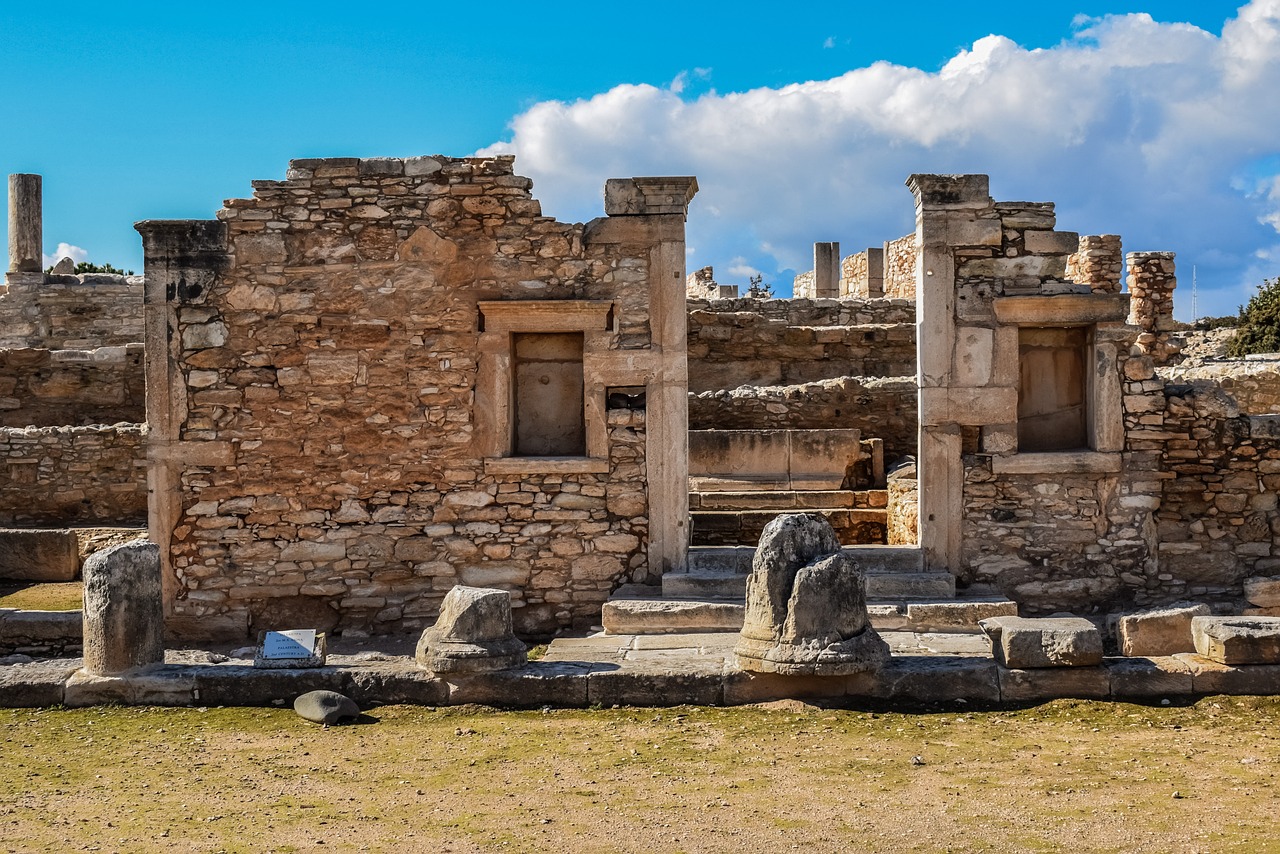The Decline of the Sumerian Civilization - Causes and Implications
The ancient Sumerian civilization, once a beacon of innovation and prosperity in Mesopotamia, faced a gradual decline that reverberated through the annals of history. The causes of this decline were multifaceted, stemming from a combination of environmental challenges, political turmoil, economic hardships, social unrest, cultural shifts, and technological stagnation. As we delve into the depths of Sumer's downfall, we unravel a tapestry of interconnected factors that unraveled the very fabric of this once-mighty civilization.

Environmental Factors
When delving into the decline of the ancient Sumerian civilization, it becomes evident that environmental factors played a crucial role in shaping its fate. The arid Mesopotamian region, where the Sumerians thrived, faced challenges such as unpredictable droughts and soil salinity. These environmental changes posed significant obstacles to agricultural sustainability, a cornerstone of Sumerian society.
The Sumerians, known for their advanced irrigation systems, struggled to cope with the increasing aridity of the land due to changing climate patterns. The reliance on agriculture as the primary economic activity made them vulnerable to fluctuations in weather conditions. As the fertile lands of Sumer turned barren, the civilization faced a looming crisis in food production.
The scarcity of water resources further exacerbated the situation, leading to conflicts over access to vital irrigation channels and fertile lands. The struggle to maintain agricultural productivity in the face of environmental degradation added pressure to an already strained society, contributing to the gradual decline of the once-thriving Sumerian civilization.
Moreover, the soil salinity resulting from improper irrigation practices hastened the deterioration of arable lands, rendering them unfit for cultivation. The inability to address these environmental challenges effectively weakened the foundation on which Sumerian prosperity rested, ultimately leading to the civilization's downfall.

Political Instability
Political instability played a crucial role in the decline of the ancient Sumerian civilization. The internal conflicts and power struggles within the ruling elite weakened the political structure of Sumer, leading to a state of vulnerability that invited external invasions. These invasions further exacerbated the instability, causing a ripple effect that ultimately contributed to the downfall of Sumer as a dominant civilization.
The power struggles among the city-states of Sumer, each vying for supremacy, created a fragmented political landscape that made it challenging to maintain a unified front against external threats. As rivalries intensified, the ability to govern effectively and respond cohesively to external pressures diminished, leaving Sumer vulnerable to conquest and subjugation by external forces.
The invasions and incursions by neighboring civilizations, such as the Akkadians and the Elamites, exploited the internal divisions within Sumer and capitalized on the weakened state of its political institutions. These external incursions not only destabilized the region further but also eroded the authority and control of the Sumerian rulers, hastening the collapse of the once-mighty civilization.
Moreover, the lack of a centralized authority capable of mediating disputes and maintaining order exacerbated the political instability within Sumer. The absence of effective governance mechanisms to address internal conflicts and power struggles left the civilization susceptible to external manipulation and domination, hastening its ultimate demise.
In conclusion, political instability, characterized by internal conflicts, power struggles, and external invasions, significantly weakened the political structure of the Sumerian civilization and played a pivotal role in its eventual decline. The inability to address these challenges effectively and maintain a cohesive political system ultimately led to the downfall of one of the world's earliest and most influential civilizations.

Economic Decline
Exploring the factors that led to the decline of the ancient Sumerian civilization and the lasting impact of its fall on the region and subsequent civilizations.
Discussing how environmental changes, such as droughts and soil salinity, contributed to the decline of the Sumerian civilization and the challenges they faced in sustaining agriculture.
Examining the internal conflicts, power struggles, and invasions that weakened the political structure of Sumer and ultimately led to its downfall as a dominant civilization.
Analyzing the economic factors, including trade disruptions, resource depletion, and the collapse of trade networks, that played a significant role in the decline of the Sumerian civilization.
The economic decline of the Sumerian civilization was a multifaceted issue that significantly contributed to its downfall. Trade disruptions, caused by conflicts and invasions, disrupted the flow of goods and resources essential for the economy to thrive. The depletion of natural resources, such as fertile land and water sources, further strained the economic sustainability of Sumer. Additionally, the collapse of trade networks that connected Sumer to other regions limited their ability to engage in commerce and acquire essential goods.
Furthermore, the economic decline of Sumer was exacerbated by the lack of diversification in their economy. Overreliance on specific industries or trade routes left them vulnerable to external shocks and fluctuations in the market. This lack of flexibility hindered their ability to adapt to changing economic conditions and maintain their prosperity.
Exploring the social tensions, class disparities, and revolts that emerged within Sumerian society, highlighting how these factors destabilized the civilization and contributed to its decline.
Examining the cultural changes, religious shifts, and loss of traditional values that occurred in Sumer during its decline, exploring how these transformations impacted the civilization's cohesion and identity.
Discussing the technological advancements and innovations that stagnated in Sumer, hindering its ability to adapt to changing circumstances and compete with emerging civilizations in the region.
Reflecting on the enduring legacy of the Sumerian civilization, its contributions to art, literature, law, and governance, and how its decline paved the way for the rise of subsequent civilizations.
Drawing parallels between the challenges faced by the Sumerians and contemporary issues, exploring the lessons that can be learned from their decline and the implications for modern societies.
Stay tuned for answers to common questions about the decline of the Sumerian civilization and its impact on subsequent societies.

Social Unrest
Social unrest played a crucial role in the decline of the Sumerian civilization, creating internal turmoil and contributing to its ultimate downfall. As the once cohesive society faced increasing class disparities and social tensions, a wave of revolts emerged, challenging the existing power structures and destabilizing the civilization from within. The growing discontent among the populace highlighted the deep-rooted issues that had been brewing beneath the surface, ultimately leading to a breakdown in social order and cohesion.

Cultural Shifts
During the decline of the ancient Sumerian civilization, profound cultural shifts took place that significantly impacted the fabric of society. The once vibrant and cohesive culture of Sumer began to unravel as traditional values eroded, and new beliefs and practices emerged. Religious shifts played a crucial role in reshaping the spiritual landscape of the civilization, with the worship of old deities waning and new gods gaining prominence.
Moreover, the loss of cultural identity became increasingly evident as Sumer struggled to maintain its distinctiveness in the face of external influences and internal turmoil. The rich artistic heritage of the Sumerians, known for its intricate pottery, monumental architecture, and cuneiform writing, faced a period of stagnation and decline as resources dwindled and patronage waned.
Class disparities within Sumerian society deepened during this period, leading to social tensions and unrest. The once cohesive social structure fractured as the gap between the wealthy elite and the common populace widened, sparking revolts and uprisings that further destabilized the civilization.
As cultural norms shifted and societal values evolved, the sense of unity that had bound the Sumerian people together began to dissipate. The decline of cultural cohesion and the erosion of traditional practices left Sumer vulnerable to external pressures and internal divisions, hastening the civilization's ultimate demise.
Overall, the cultural shifts that occurred during the decline of the Sumerian civilization underscore the profound impact of changing beliefs, values, and social dynamics on the stability and longevity of a society.

Technological Stagnation
Exploring the factors that led to the decline of the ancient Sumerian civilization and the lasting impact of its fall on the region and subsequent civilizations.
During the twilight years of the Sumerian civilization, a shadow of stagnation loomed over their once vibrant society. The lack of significant technological advancements became a hindrance, preventing them from keeping pace with the rapidly evolving world around them. While other civilizations were embracing new tools and techniques, the Sumerians found themselves trapped in a cycle of outdated practices.
Imagine trying to navigate a vast ocean with a sail made of straw while others are sailing with sturdy ships equipped with advanced navigation systems. This technological stagnation left the Sumerians vulnerable and unable to compete effectively with neighboring cultures that were embracing innovation and progress.
The absence of technological growth meant that the Sumerians struggled to adapt to changing circumstances, such as shifts in trade routes or agricultural practices. Their failure to innovate and enhance their technological capabilities ultimately contributed to their inability to sustain their civilization in the face of mounting challenges.
Reflecting on the enduring legacy of the Sumerian civilization, its contributions to art, literature, law, and governance, and how its decline paved the way for the rise of subsequent civilizations.
Drawing parallels between the challenges faced by the Sumerians and contemporary issues, exploring the lessons that can be learned from their decline and the implications for modern societies.
1. What were the main environmental factors that contributed to the decline of the Sumerian civilization?
2. How did political instability weaken the foundations of Sumerian society?
3. What role did economic factors play in the downfall of the Sumerian civilization?
4. How did social unrest impact the cohesion of Sumerian society?
5. What lasting cultural shifts occurred during the decline of the Sumerian civilization?
6. How did the legacy of the Sumerian civilization influence subsequent cultures in the region?
7. What lessons can modern societies learn from the technological stagnation of the Sumerians?

Legacy of the Sumerian Civilization
As we reflect on the legacy of the Sumerian civilization, we are confronted with a rich tapestry of contributions that have left an indelible mark on human history. The Sumerians, known for their advanced knowledge in various fields, have bequeathed to us a legacy that transcends time and continues to influence modern society.
One of the most significant aspects of the Sumerian legacy is their contributions to art and literature. The Sumerians were prolific writers and poets, creating some of the earliest known works of literature, such as the Epic of Gilgamesh. Their intricate clay tablets adorned with cuneiform script not only preserved their stories but also served as a foundation for future literary endeavors.
In the realm of governance and law, the Sumerians established the world's first known civilization with a complex system of laws and regulations. The Code of Ur-Nammu, one of the earliest legal codes in history, provided a framework for justice and governance that influenced subsequent legal systems around the world.
Furthermore, the Sumerians made significant advancements in mathematics and astronomy, laying the groundwork for future scientific discoveries. Their sophisticated understanding of mathematics, including the development of the sexagesimal system and the concept of dividing the circle into 360 degrees, revolutionized numerical calculations and paved the way for future mathematical innovations.
Additionally, the Sumerians' architectural achievements, such as the construction of ziggurats and irrigation systems, showcased their engineering prowess and ingenuity. These structures not only served practical purposes but also reflected the Sumerians' religious beliefs and societal organization.
Despite the eventual decline of the Sumerian civilization, its legacy endures through its enduring contributions to art, literature, law, governance, mathematics, and architecture. The echoes of Sumerian achievements resonate through the corridors of history, reminding us of the remarkable accomplishments of this ancient civilization and the lasting impact it has had on human civilization.

Lessons for Modern Societies
As we reflect on the decline of the ancient Sumerian civilization, there are valuable lessons that modern societies can learn from their experience. The challenges faced by the Sumerians offer insights into how environmental, political, economic, social, cultural, and technological factors can interact to bring about the downfall of a once-thriving civilization.
One crucial lesson for modern societies is the importance of environmental sustainability. The Sumerians struggled with environmental changes such as droughts and soil salinity, which significantly impacted their ability to sustain agriculture. This serves as a reminder of the need for responsible stewardship of the environment to ensure long-term prosperity.
Additionally, the political instability that plagued Sumer highlights the dangers of internal conflicts and power struggles. Modern societies can learn the importance of fostering stable governance structures and resolving disputes through peaceful means to prevent the erosion of political stability.
The economic decline of the Sumerian civilization underscores the need for diversified economies and resilient trade networks. By analyzing the factors that led to economic disruptions in Sumer, modern societies can better prepare for potential challenges and mitigate the risks of resource depletion and trade collapses.
Social unrest within Sumerian society serves as a cautionary tale about the dangers of ignoring class disparities and societal tensions. Modern societies can benefit from addressing social inequalities and promoting social cohesion to prevent internal divisions that can weaken the fabric of a civilization.
Furthermore, the cultural shifts in Sumer highlight the importance of preserving cultural heritage and traditional values. By understanding how cultural changes can impact the cohesion of a society, modern societies can work towards preserving their unique identities while embracing progress and innovation.
Technological stagnation in Sumer serves as a reminder of the need for continuous innovation and adaptation. Modern societies must prioritize technological advancements to remain competitive in a rapidly evolving world and avoid falling behind due to complacency.
In conclusion, the decline of the Sumerian civilization offers a wealth of lessons for modern societies to heed. By studying the complex interplay of environmental, political, economic, social, cultural, and technological factors that contributed to the downfall of Sumer, societies today can better prepare for the challenges they may face and strive towards a more sustainable and resilient future.
Frequently Asked Questions
- What were the main environmental factors that contributed to the decline of the Sumerian civilization?
The main environmental factors that played a role in the decline of the Sumerian civilization included droughts and soil salinity. These challenges made it difficult for the Sumerians to sustain agriculture, which was crucial for their society.
- How did political instability impact the downfall of the Sumerian civilization?
Political instability, characterized by internal conflicts, power struggles, and invasions, weakened the political structure of Sumer. This instability ultimately led to the collapse of Sumer as a dominant civilization in the region.
- What economic factors contributed to the decline of the Sumerian civilization?
The economic decline of the Sumerian civilization was influenced by trade disruptions, resource depletion, and the collapse of trade networks. These factors played a significant role in the economic struggles faced by the Sumerians.
- What social tensions emerged within Sumerian society during its decline?
Social unrest in Sumer was fueled by class disparities, tensions, and revolts that emerged within the society. These factors destabilized the civilization and contributed to its eventual decline.
- How did technological stagnation impact the ability of Sumer to compete with other civilizations?
The technological stagnation in Sumer hindered its ability to adapt to changing circumstances and compete with emerging civilizations in the region. This lack of technological advancement put Sumer at a disadvantage in the ancient world.



















